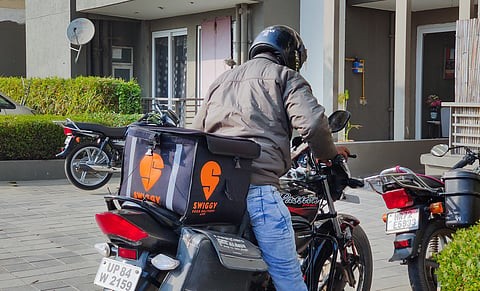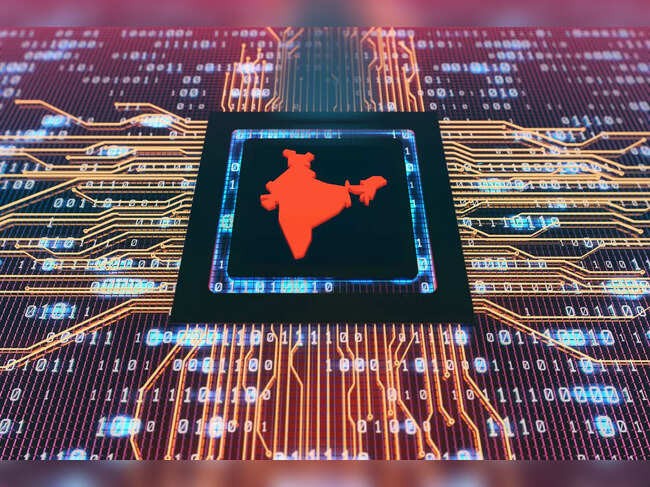



India’s rapidly growing gig economy has become vital to urban services, but extreme heatwaves are exposing serious gaps in worker protection. Delivery partners, cab drivers, and other platform-based workers are forced to work long hours outdoors without shade, hydration, or social security benefits—putting their health and livelihoods at risk. While advisory measures exist, enforcement remains weak and retaliation against workers raising concerns is common. To sustain both productivity and human dignity in a warming climate, India must strengthen legal safeguards, ensure heat-safety infrastructure, and expand social protection for gig workers.

Copyright infringement not intended
Picture Courtesy: Down to Earth
Summers of 2024 and 2025 saw some of India’s most extreme heatwaves, with heat indices exceeding 50°C in northern and central cities. Gig workers delivery riders, cab drivers, sanitation staff, and app-based service providers—bear the brunt of these conditions, working outdoors while the public stays indoors.
According to India’s Code on Social Security, 2020, a gig worker is defined as a person who performs tasks or engages in work arrangements outside the conventional employer-employee framework, earning income from such activities.
The gig economy refers to a labour system where individuals or companies engage in short-term, task-based work facilitated through digital platforms. These platforms connect service providers directly with customers, allowing workers to earn on a per-task or project basis, rather than through a traditional employment contract
Types of Gig Workers
Platform-Based Workers
These workers operate through online platforms or mobile applications. Examples are Food delivery: Zomato, Swiggy, Ride-hailing: Ola, Uber, E-commerce deliveries: Amazon, Dunzo.
Non-Platform Workers
Individuals who work on a casual, freelance, or self-employed basis in traditional sectors. This category includes Part-time tutors or trainers, Freelance designers or artists, Self-employed domestic helpers, Casual labourers in construction or other sectors
|
Stakeholder |
Pros |
Explanation |
Cons |
Explanation |
|
Workers |
Flexibility & Autonomy |
Gig work enables choosing when, where, and how long to work helping students, women, caregivers, differently-abled persons participate in the labour market. Supports second-income earners and encourages labour mobility across sectors and regions. |
Lack of Social Protection & Benefits |
Gig work falls outside traditional employer–employee structures, so workers lack paid leave, maternity/paternity benefits, provident fund, pension, and health insurance. Exposes them to poverty risks during illness, unemployment, or old age. |
|
Independence & Ownership of Work |
Workers manage tasks independently, increasing empowerment and professional satisfaction. Builds entrepreneurial mindset and personal agency. |
Income Volatility & High Tax Burden |
Earnings depend on market demand, user ratings, and seasons. Workers must self-manage income tax, GST, and expenses like fuel, devices, insurance — reducing net income. |
|
|
Diverse Work Opportunities & Skill Enhancement |
Exposure to multiple clients improves skillsets, digital literacy, productivity, and adaptability — essential for future employability. Enables portfolio-building and global employment opportunities. |
Isolation, Stress & Limited Support Systems |
Work is mostly solitary with no institutional grievance redressal. Leads to mental stress, burnout, and vulnerability to unfair contract terms. Limited unionisation weakens bargaining power. |
|
|
Potentially Higher Earnings & Upward Mobility |
High-demand digitally skilled workers (design, coding, analytics, AI) can earn global income. Pay-per-task model enables income scaling through multiple gigs. Enhances participation of youth in digital economy. |
Job Insecurity & Algorithmic Exploitation Risks |
Ratings-based allocation of work creates pressure and wage suppression. Sudden account deactivation, unfair penalties, and opaque platform policies lead to precarity. Workers have little negotiation power. |
|
|
Businesses |
Cost Efficiency & Lean Operations |
Reduces expenditure on hiring, HR management, social security contributions, office setup, and long-term liabilities. Supports competitiveness in low-margin sectors like logistics and retail. |
Reliability & Quality Control Issues |
Gig workers may prioritize platforms offering higher pay/demand. Lack of loyalty or long-term engagement may affect service consistency, brand reputation, and customer satisfaction. |
|
Rapid Scalability & Market Agility |
On-demand workforce helps startups and MSMEs scale quickly, manage seasonal fluctuations, and enter new markets without heavy investment. Encourages innovation-linked growth (e.g., hyperlocal delivery boom in India). |
Legal & Regulatory Uncertainty |
Governments globally tightening rules on platform worker rights. Misclassification cases lead to back-pay, tax penalties, and litigation (e.g., AB5 in California, Supreme Court verdict on Uber UK). |
|
|
Access to Global & Diverse Talent Pool |
Enables companies to hire specialized skills (AI, cyber security, design) without geographical limits. Enhances productivity, creativity, and operational coverage across time zones. |
Data Security & Compliance Challenges |
Outsourced gig workers may pose intellectual property risks. Managing digital records, platform contracts, and compliance monitoring increases costs. |
Health risks: dehydration, heat exhaustion, heat-stroke, other illnesses
A 2024-survey of gig workers (by Telangana Gig and Platform Workers Union (TGPWU) & Heat Watch) found 52% of respondents reported heat exhaustion, and 30% reported heat-stroke symptoms in extreme summer conditions.
Women workers reported worsened menstrual cramps, urinary tract infections linked to extreme heat, dehydration, lack of access to clean water and toilets.
Reduced productivity, income loss & economic instability
Heat not only impacts health but also undermines financial stability of gig workers who largely depend on daily wages. For those with thin margins, even a few lost orders can mean serious hardship. In Bengaluru, trade-unions reported that riders who usually complete 20–25 orders/day dropped to 15 or fewer orders on hot days — directly reducing earnings.
Lack of basic protective infrastructure: shade, water, rest, sanitation, health coverage
Many workers report no access to shaded waiting areas, rest-spaces, clean drinking water or toilets during working hours, especially while waiting outside restaurants, warehouses, or pickup points.
The TGPWU/Heat Watch survey found that a substantial majority demand “clean water and toilets” and “shaded rest areas”; over 43% asked for “breaks during peak heat hours” with compensation.
Structural precarity: inability to refuse gigs, algorithmic pressure, and risk of punitive actions
Gig workers often don’t have real freedom to refuse assignments — accepting or rejecting jobs can affect their ratings, future assignments, and income.
|
Ethical Concerns of Gig workers working in heatwave condition Occupational Health & Safety Neglect: Heatwaves expose gig workers to dehydration, heat exhaustion, stroke and long-term organ damage. Dignity and Human Rights Concerns Working in 45–50°C temperatures for basic survival violates: Right to health, right to safe work, and right to life with dignity |
Enforceable heat-safety regulations: Introduce a National Heat Safety Code that mandates:
Universal Social Security Access: Operationalise the Social Security Fund under the Code on Social Security, 2020. Ensure accident and heat-stroke insurance for all gig workers with cashless treatment at nearest hospitals and seamless claims process linked to e-Shram ID.
Heat-Smart Urban Infrastructure: Convert bus stops, petrol pumps, and warehouses into designated cooling shelters. Provide public drinking water points along high-density delivery routes.
Climate-Linked Income Protection: Guaranteed minimum hourly pay when heat advisories reduce outdoor working windows. Paid leave for certified heat-stress illness.
Establish a minimum wage policy for gig workers to ensure a stable income and minimum number of paid hours or earnings. For example: Singapore’s proposed legislative changes include extending work injury insurance and pension coverage to gig workers, which India could emulate.
The gig economy has emerged as a major employment generator, particularly for youth and low-skilled workers in urban India. However, climate-induced extreme heat events are exposing gig workers—especially outdoor delivery partners, ride-hailing drivers, and construction-based freelancers—to severe health risks and income instability. The absence of social security, insurance coverage, and weather-based work protection further deepens their precarity. Strengthening occupational safety standards, ensuring heat-stress protection measures, expanding social security under the Code on Social Security, 2020, and promoting climate-resilient urban planning are essential to safeguard the dignity, productivity, and well-being of this growing workforce in a warming world.
Source: Down to Earth
|
Practice Question “Extreme heat events are transforming the vulnerabilities of India’s gig workforce.” Discuss (150 words) |
Gig workers are individuals who earn income by performing short-term, task-based work, often mediated through digital platforms such as ride-hailing, food delivery, and freelancing services.
A majority work outdoors or in unregulated conditions, with exposure to high temperatures, long travel hours, and limited access to rest, water, and shade—leading to heat stress and health risks.
NITI Aayog (2022) estimates 7.7 million gig workers in India, projected to reach 23.5 million by 2030, forming a major part of the urban informal economy.








© 2025 iasgyan. All right reserved